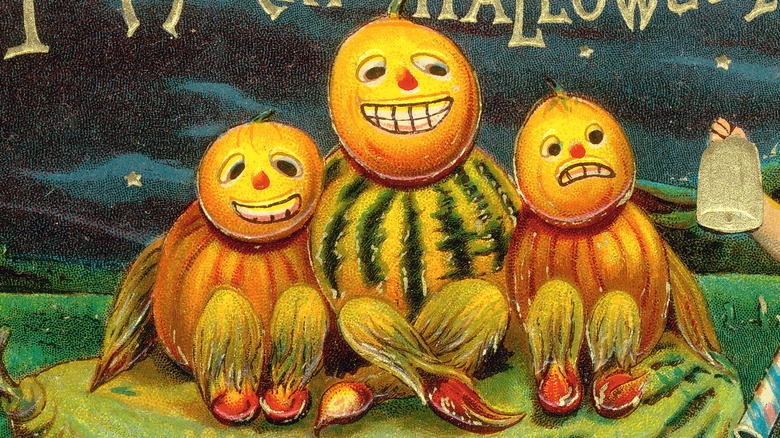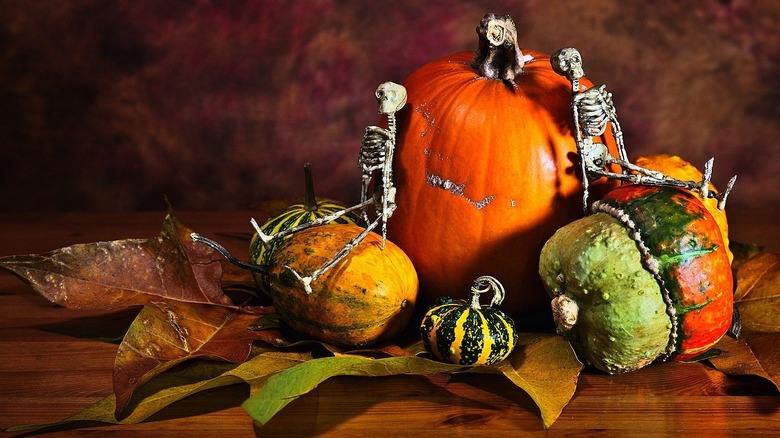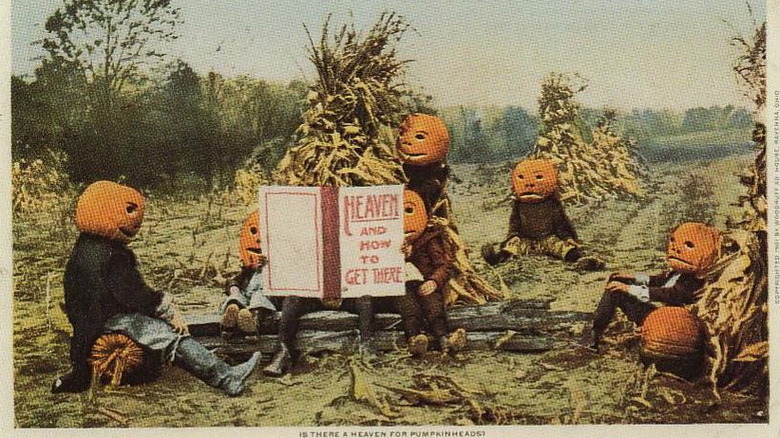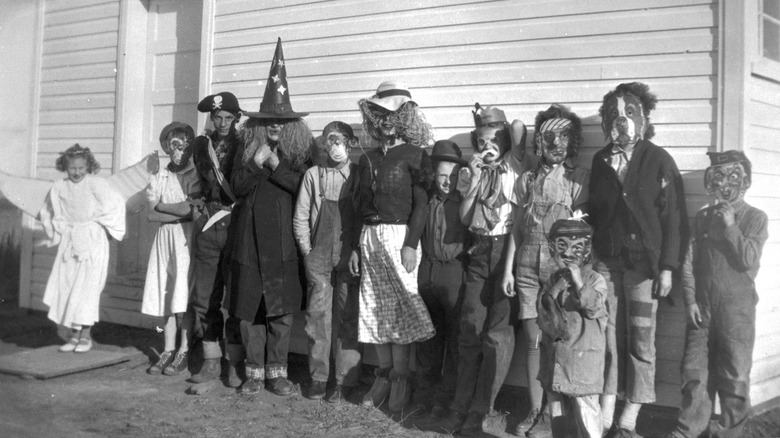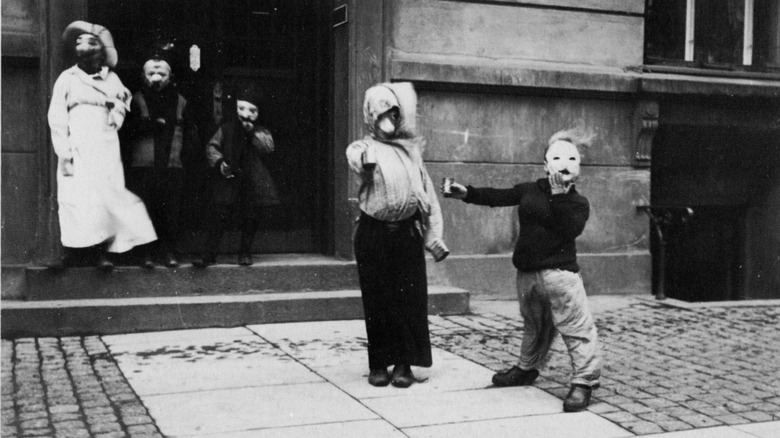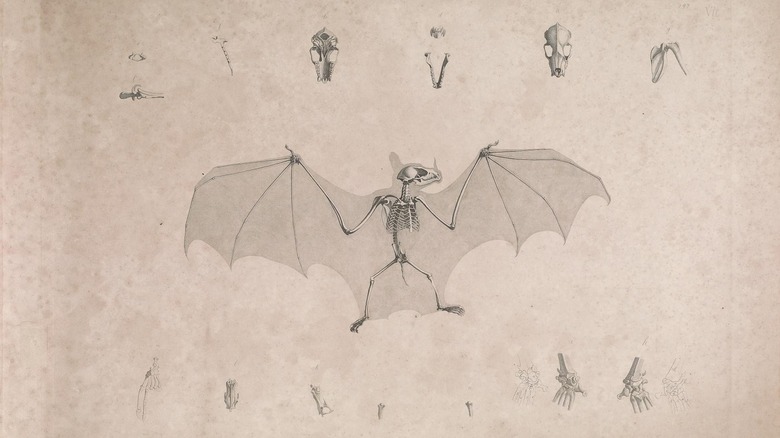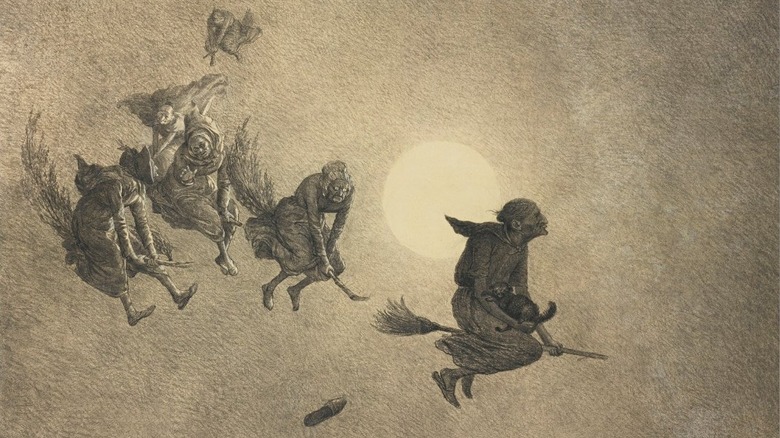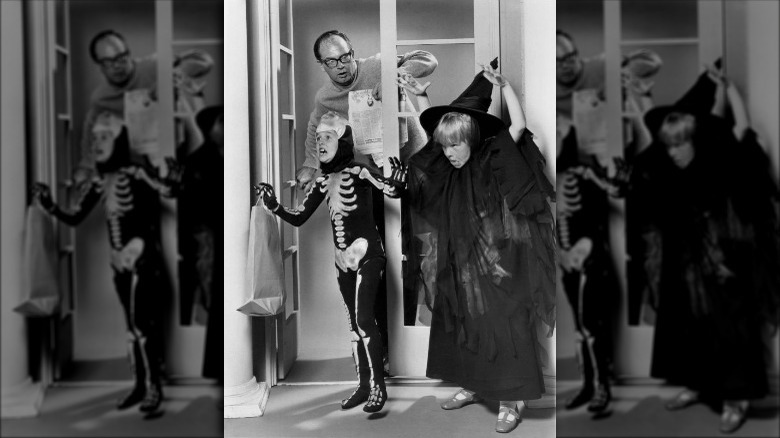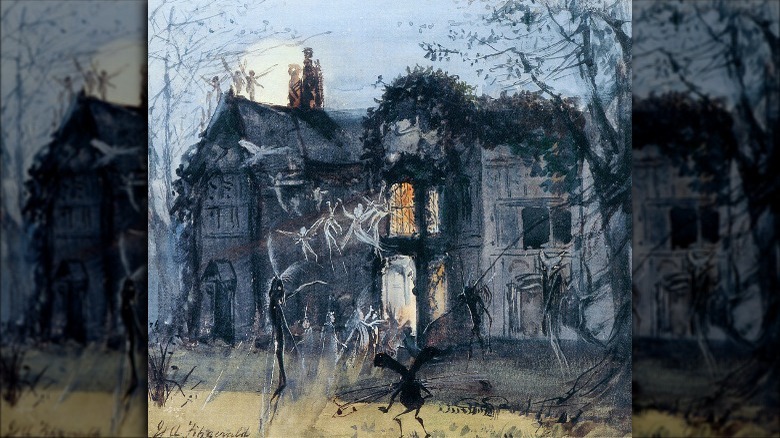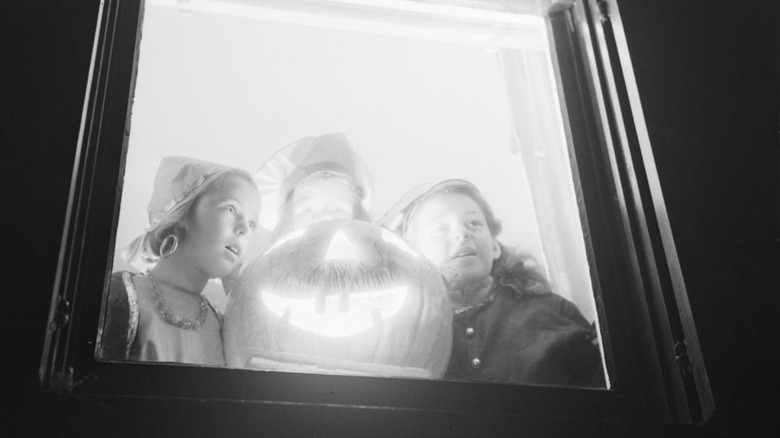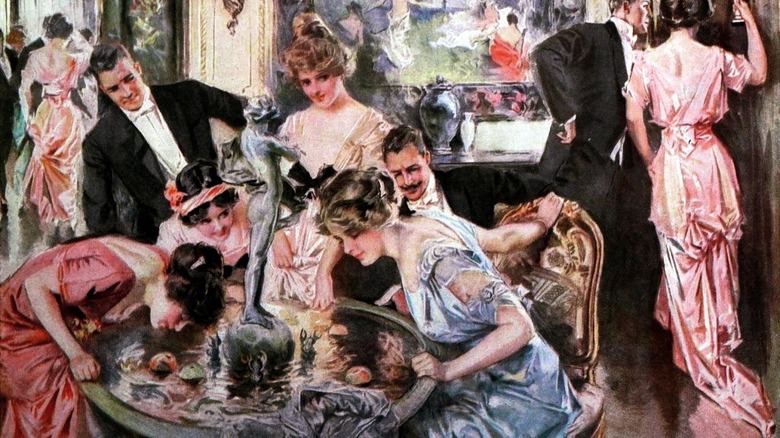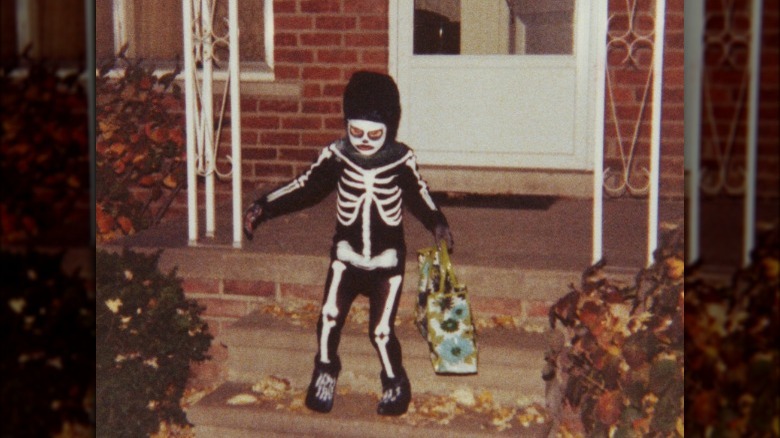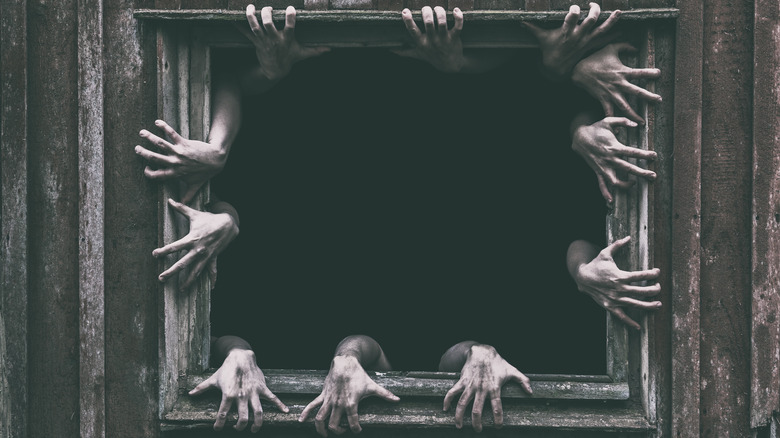The Messed Up History Of Halloween
It's easy to dismiss Halloween. A standard American celebration of the autumn holiday seems pretty kid-focused, with its trick-or-treats, its superhero tie-in costumes, and any number of goofy cartoons celebrating the season. Sure, you might get a somewhat more mature experience at some Halloween parties, haunted houses, or while watching a gory slasher flick, but even then, it's all pretty innocuous.
That is, until you start looking into the history of Halloween. And, no, we're not necessarily talking about a literally demonic past, though the fears stirred up by certain denominations of Protestant Christians have definitely lent their own tinge of horror to the proceedings. In truth, many of the seemingly innocent things about the holiday, from candy, to jack-o'-lanterns, to the silly witch cutout in an elementary school classroom, hold surprisingly dark meanings after all. Many of the rituals and iconography of this celebration have their roots in ancient European cultures. This is the messed up history of Halloween.
Halloween started as an ancient death festival
Once upon a time, Halloween wasn't just an occasion for kids to get dressed up in costumes and go begging for candy from door to door. If you go back far enough in history, you'll find that Halloween has its roots in an ancient festival that marked the end of a fruitful harvest and the coming of a cold winter. Oh, and also death.
According to History, the ancient Celtic festival of Samhain (pronounced "sah-win" for those not already in the know) was something of a new year celebration. Held around November 1 in today's calendar, it acknowledged that the warm and lush seasons of spring and summer were coming to a close. In their place, the cold and hard times of autumn and winter were to take over.
Many believed that In this transitional period between the life-giving part of the year and the seasons that could potentially take it all away, the dead were closest to the living. Some dead spirits could be communicative or even helpful, while others might prove to be more troublesome. Deities were also appeased with bonfires and sacrifices, while religious leaders such as Druids attempted to foretell the future with assistance from the spiritual energy thought to be at its peak then.
The jack-o'-lantern origin story is literally haunting
Nowadays, a cheerful little jack-o'-lantern is a classic symbol of Halloween, but the cartoonish depictions of a grimacing gourd don't really speak to the dark legend behind it all. Most versions of the jack-o'-lantern legends center on a tricky man named — what else? — Jack. History reports that an Irish version of the legend actually refers to the man as Stingy Jack for his overly thrifty nature. This Jack was such a penny-pincher that, upon inviting the Devil to drink with him for some reason, he managed to get the fiend to transform into a coin to settle the tab. Jack quickly pocketed the devil-coin next to a silver cross, only releasing the demon on the promise that he wouldn't claim Jack's soul when the man died.
That worked fine at first. The Devil kept his promise upon Jack's death and left the man alone. Yet, it turned out that God didn't want him either, leaving Jack to wander the earth as a spirit. At least the Devil gave Jack a hollowed-out turnip with a glowing coal to light his way.
Eventually, as Irish people began to emigrate to America, the legend came with them, according to National Geographic. Only, it turned out that the New World crop of pumpkins was more plentiful and suitable to carve than a hard old turnip or other root vegetable, and thus the gourd-based jack-o'-lantern was born.
Halloween costumes were meant to avoid evil spirits and mess with neighbors
The tradition of wearing Halloween costumes may go back to the old days of Samhain, when disguising oneself had both a religious and a practical side. According to CNN, costumes worn around this time of year were meant to help wearers avoid scrutiny from wandering spirits. The disguises usually employed skins, horns, and other preserved animal bits to conceal the wearer and help them fit in with the otherworldly.
But, as the holiday adapted, those costumes also helped to conceal the identity of pranksters who bothered people in their community. And, conveniently enough, they could often blame the mischief on ghosts.
As Christians began to move into Celtic regions, Samhain slowly began to transition to a more neutered version of itself, with the faithful expected to spend the next day in religious observance, says SyFy. But costuming still continued, with some people going door to door, begging for treats like soul cakes in exchange for offering up their own prayers for departed souls.
Trick or treating was more about dead souls than candy
Trick or treating seems like a pretty sweet state of things, all considered. A cute little kid dresses up in a costume, goes from door to door, and gets candy in exchange for the ritualized phrase "trick or treat." But, in medieval Europe, that interaction was more of a two-way street, at least spiritually speaking. And someone's very soul could hang in the balance.
Trick or treating has its roots in a begging practice that's known under a variety of names, including "souling" and "guising," according to History. Richer folks would receive the poor of their communities on their doorsteps and give them soul cakes, a special seasonal pastry. Those who received the cakes then promised to pray for the souls of the household's dead relatives, hopefully speeding some spirits out of purgatory and into heaven just a little sooner.
Eventually, kids started to take up the practice and added in costumes and song-and-dance routines. Instead of receiving a cake, they might receive other food, money, or even a nip of ale (it was the Middle Ages, after all). Digital Medievalist reports that records of some of the souling songs have survived, which include "A Soule-cake, a Soule-cake,/Have mercy on all Christen soules for a Soule-cake." Perhaps not the cheeriest, but if you were a hungry beggar waiting on a spiced and sweetened cake at the spookiest time of year, you'd sing, too.
Halloween animals have a witchy origin
Bats are actually a pretty helpful member of the ecosystem that, depending on the species, can help to pollinate plants and gobble up troublesome insects, according to the National Science Foundation. But they also have a spooky reputation and very often turn up in Halloween decorations.
True to their nature, some bats may have been attracted to the tasty insects drawn by Samhain bonfires, says Popular Science. Many bat species are also nocturnal, further increasing their supposed association with ghosts, pagan deities, and the underworld. It's unsurprising that in the popular imagination, they have gone from a pretty innocuous if cool-looking flying mammal to a harbinger of Halloween tidings.
Meanwhile, the witchy reputation of black cats made them an easy fit for the spooky holiday. After all, how often do you see a ginger or tabby cat in a Halloween display? According to American Folklore, the association between Halloween and black cats may have started in the Middle Ages, when people were often frantically working to root out evil witches in their midst. Those cats, with their eerie dark coats, were frequently associated with evildoers working at night. Some even believed that black cats were witches who had the power of transformation at their disposal. Soon enough, the black cat gained an eerie reputation, which was further spread when European immigrants took their tales and traditions across the Atlantic Ocean to the Americas.
The Halloween witch has a complicated history
If you're looking for a classic Halloween costume, you surely can't go wrong with a witch getup. Among the various ghouls and goblins that are associated with the occasion, it's quite possibly the witch that has one of the longest lineages. But if you think that the witch is only a cackling cartoon caricature and nothing more, you're sadly mistaken.
Real witches — or at least the people throughout history who were accused of being real witches — were probably pretty sad about their association, too. That's because the real history of the witch is one that's full of fear and suffering, says the BBC. Accused witches were caught in the great religious upheaval of the Reformation, where Catholic and Protestant Christians alike were concerned with creating the ideal religious society. And, of course, anyone who didn't happen to fit in with the particular society was at risk for torture, trials, and death sentences. That certainly didn't ease up in the New World, where the Salem Witch Trials and other panics took place in a misguided attempt to root out suspected evil.
Nowadays, as Smithsonian Magazine notes, the Halloween witch has grown downright cute, whether she's seen with a warty nose or a rather short skirt. Yet, knowing the sad tale of European and America's witch trials, it's hard to forget her darker historical edge.
People once took the trick part of trick or treat more seriously
According to Time, the night before Halloween is often called Mischief Night in New Jersey. It's also more ominously known as Devil's Night in Detroit and, confusingly to outsiders, Cabbage Night in parts of the northeastern United States. The evening has historically represented an opportunity for widespread misbehavior and destruction, a full lean-in to the "trick" portion of "trick or treat." And, while many might like to blame it all on rotten kids, there's actually a more concrete social and historical explanation for the hellraisers.
Mischief and pranking neighbors have been a part of Halloween since its beginnings as a Celtic ritual. History reports that one especially awful trick in 19th century Scotland involved setting a smoldering cabbage stalk up against a keyhole, so that the unfortunate homeowner would arrive at a house reeking of burned cruciferous veggies.
Immigrants brought these traditions to the U.S., and the mischief really seemed to ramp up to frantic levels in the 1930s. As Time points out, some historians have argued that the increasing stresses of the Great Depression and, later, World War II, could have pushed some youths to act out.
Haunted houses were a desperate attempt to stop Halloween destruction
It turns out that the Great Depression has more of a hand in contemporary Halloween celebrations than you may expect. Even when you go to a haunted house attraction, there's just a hint of its history still there among the jump scares and grotesque characters.
According to History, it all started when Halloween pranks got out of hand in the early days of the Great Depression. With youths going so far as to flip cars and nearly derail trains with their antics, adults decided that something must be done. The kids needed a more controlled distraction. Enter the haunted house, one of any number of organized Halloween festivities that included trails, parades, and trick-or-treat events. The reasoning went that if the kids were in an organized haunted house, then they couldn't be tearing the town to pieces. And, if a local nonprofit got to make a bit of money off it, all the better.
Maybe this seems rather cheesy to modern readers, especially those who are used to the intense, professionally produced haunted attractions available today. But even these gentler haunted houses were better than some community's ideas to completely ban Halloween fun altogether. Per History, some cities seriously considered the idea, but realized that the angry trick or treaters, denied their opportunity for spooky fun, might prove to be too much to deal with in the face of such an extreme measure.
World War II pumped the brakes on Halloween
If annoying and even dangerous pranksters weren't enough to stop Halloween, World War II was, at least for a short time. According to America in WWII, in 1942, Chicago and some other cities really did cancel Halloween celebrations, and not strictly because of all those wild pranksters. Instead, it was because of increasing restrictions on resources during wartime.
Patriotism also came into play. One superintendent of schools in Rochester wrote that even the seemingly innocuous prank of soaping up someone's windows wasn't all that great. After all, didn't our boys overseas need that soap and grease more? And ringing doorbells and then running away was just another way to make the life of an exhausted wartime factory employee all the more tiresome.
History reports that some kids were even pushed to take pledges to behave themselves, promising to "back our fighting men by observing Halloween as they would want me to" — in wholesome, squeaky-clean fashion. This meant that, for a while at least, the mailboxes and front porches of local homes were safe. Things didn't really get back to normal until after the war, when much of that virtuous mindset persisted among a largely tamed group of American trick or treaters.
Some Halloween traditions come from people seeking romance
While kids were out turning the town upside down for much of modern Halloween history, young adults in many communities were tasked with something far more frightening: finding a spouse.
Even in the Christianized communities of the colonized U.S., something remained of the old ways. Autumn was still a time of year where people felt more inclined to fortune telling, and, as NPR reports, many anxious young romantics in Europe and the Americas used apples to do so. It makes sense, really, considering the long link between fruit and fertility, and also the fact that apples are pretty abundant at the close of the harvest season.
Apple bobbing was a way for people to get a hint at a future match. In some cases, young women would make a secret mark on an apple, put all the apples in a large bucket of water, and then watch the young men stick their heads in the bucket and come out with a fruit. The girl who made the mark was said to be matched with the boy who retrieved the apple. Others might attempt to peel an apple in one continuous piece and then toss the scrap over their shoulder. They would then turn to see if the peel had formed an initial, which would supposedly indicate the name of the one fate intended for them.
Some people have argued that trick or treating is extortion
While trick or treating may now seem like a pretty harmless childhood tradition, some busybodies have argued that it's really extortion. Whether or not you agree, the practice does kind of look that way when it's considered in a certain light. As explained by in "Gangsters, Pranksters, and the Invention of Trick-or-Treating, 1930–1960," the practice does involve kids asking for candy as a form of protection money, after all. Consider what might happen to the front of your home if you're stingy with the candy, or especially if you commit the ultimate Halloween sin of handing out something awful like dental floss. It's certainly more of a one-way street, though you could always try to ask kids to pray for souls stuck in Purgatory if you're feeling a bit old-school and want to harken back to medieval tradition. At least they'd be doing some extra work for all that sugar.
This distrust between trick or treaters and candy-distributing adults may have its roots in the 1930s, when tricking was definitely more popular for some than scrounging for treats. The article includes accounts of people who report that, when they ran out of candy or refused to open up for the little extortionists, were met with retribution in the form of tipped-over trash cans and ruined birdbaths. And some alarmist newspapers even went so far as to claim that the rougher sort of trick or treaters were "The Gangsters of Tomorrow."
Hell houses are a dark answer to Halloween haunted houses
For many observant religious people, and especially evangelical and fundamentalist Christians, Halloween is the "Devil's holiday," which should be feared because of its pagan associations. After all, as Christianity became the dominant religion in Europe and, later, the Americas, it had a vested interest in literally demonizing the old gods. Some early Christian practices folded the pagan observances into its calendar, as in when, in the 8th century, Pope Gregory III moved All Saints' Day from May 13 to November 1 in an attempt to put a Christian gloss on the spookiest time of year (via How Stuff Works). However, quite a few Protestants eventually felt that this was still too close for comfort, especially, Time says, as the latter half of the 20th century saw a rise in evangelical Christianity.
Starting in the 20th century, some Christians even went so far as to have anti-Halloween parades (via "Halloween: The History of America's Darkest Holiday") and attractions known as hell houses that graphically depicted the consequences of sin. And, as Pacific Standard reports, some hell houses do not hold back, warning of the bloody, satanic perils of issues such as drunk driving and domestic abuse, as well as more divisive topics such as gay marriage and abortion.
